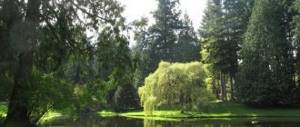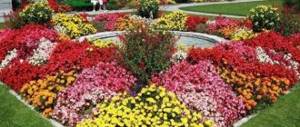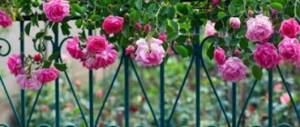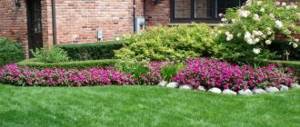Choosing and preparing a place for planting with your own hands
In order for a flowerbed to please with its decorative properties, it is worth choosing the right place for it. It must meet the following criteria:
- sufficient lighting;
- lack of wind;
- fertile soil.
Roses are not recommended to be planted in low or too wet places. Also, overly shady areas are not suitable for plants.
At the wall of the house
This arrangement helps protect the plants from wind and frost. In order for plants to develop normally, it is necessary to maintain an interval of 50-60 centimeters between them and the structure.
At the fence
Such hedges have excellent decorative properties. At the same time, you should make sure that the plants are not in the shade. It is recommended to plant them 50 centimeters from the structure.
Along the edges of the garden path
This landing option looks very impressive. At the same time, it is possible to provide plants with favorable conditions for development.
Near swings, gazebo, benches
Flowerbeds are often placed in recreation areas. They can be placed near swings, gazebos, and benches.
Soil requirements
If groundwater is located 2 meters from the surface of the earth, it is worth ensuring high-quality drainage. To do this, it is recommended to remove 70 centimeters of soil and pour gravel into the trench, and then return the soil back.
Seedlings need fertile soil that allows moisture and air to pass through. If the soil initially has a heavy consistency, it is worth adding sand or peat. It is also permissible to make a composition based on the following components:
- 2 buckets of peat;
- 2 buckets of compost;
- 1 bucket of loam;
- 5 liters of sand;
- 5 liters of vermiculite.
Recommended color combinations
In order for the flowerbed to look harmonious, it is worth thinking through it to the smallest detail. It is recommended to take into account color combinations.
Elegant and calming
To make the plantings look elegant and at the same time have a calming effect, you should use white or green roses. The varieties Bolero, Mont Blanc, and Iceberg look great.
In pastel colors
Roses in cream, lilac, and white tones are suitable for this. Light pink flowers look great. Suitable options are the varieties Novalis, Elina, Flamingo. It is permissible to plant Pomponella and Helena plants.
Bright
To make a rich flower bed, you should use yellow, purple, and red roses. An excellent solution would be orange flowers. Popular varieties include Masquerade, Arthur Bell, Casanova. Monica and Gloria Day look no less successful.
Contrasting
To decorate such a flower bed, use 2 colors that are in harmony with each other. Red and white roses go well together. The combination of yellow and purple varieties looks no less successful. The plants Black Magic, Cardinal, Cherry look good.
Unusual
In this case, it is worth using roses in pastel shades in combination with bright accents. Plants of delicate flowers can be combined with bushes that are decorated with purple, crimson, and orange petals. Recommended varieties include Chopin, Ingrid Bergman, Cherry Brandy.
Roses in the landscape: combination with other flowers
A flower garden in a garden may include exclusively roses or various flower crops. If you are planning a mono composition, consider the following recommendations:
- It is unacceptable for several colors to be used in one spot.
- There should be no pink, purple or orange flowers near red roses.
- Roses of pale pink and pale blue shades go well together. Orange looks great with purple, white with blue, red with lilac, blue and green.
- It is advisable to include one variety in the composition.
Related article:
How to transplant an adult rose
To combine a rose with other plants, you will have to listen to the advice of flower growers:
- Muscariae, crocuses, scylla and snowdrops will decorate the composition in early spring.
- Shrubs with gorgeous flowering or fruiting look great in a flower bed. You will have to place them at a distance of at least 1 m. In this regard, juniper, thuja, spruce, pyracantha, magnolia, and cotoneaster are ideal.
- The best neighbors of roses are snowberry, privet, lilac, euonymus, and mock orange.
- Near the roses, other flowering plants with blue, purple, silver or blue buds or leaves will look advantageous. But too bright shades are not welcome.
- Roses complement decorative cereals and climbing vines well.
Good neighbors for roses
To beautifully decorate a flower bed, it is recommended to choose the right additions to roses.
Clematis
Clematis bushes go well with climbing roses. It is worth considering that they are characterized by powerful roots. Therefore, clematis is planted with an adult rose, and not vice versa.
Primrose
These plants should be planted densely enough so that they form a continuous carpet. Thanks to this, the flowerbed will look bright in early spring.
Ageratum
This beautiful annual plant forms rounded bushes. They go great with roses - especially white and blue shades.
Violets
These flowers look delicate and sophisticated. That's why they go well with roses.
Phloxes
These flowers come in different shades, but white and blue varieties look best in the rose garden.
Cuffs
These are large bushes that go well with tall or climbing roses.
Geranium
A popular option for decorating a flower bed is geranium. This is a beautiful culture that is distinguished by a powerful root system.
Silver wormwood
Classic silver wormwood goes well with pink and burgundy roses.
Bulbous primroses
Crocuses, daffodils and tulips come in a variety of colors. Therefore, it is permissible to combine them with roses.
Verbena
This plant is also called pigeon grass. It has excellent decorative properties and different shades.
Stock rose
These plants are also called hollyhocks. They harmoniously complement any flower bed options, and the rose garden is no exception.
Cosmea
This crop is also called Mexican aster. It looks elegant and complements the rose garden perfectly.
Levkoy
This plant helps to create a graceful and elegant flower garden. The undoubted advantage of gillyflower is its amazing aroma.
Bells
Large blue or milky bells perfectly complement the flower garden. At the same time, designers advise placing them at the back, which allows you to get a beautiful background.
Gypsophila
This crop is characterized by abundant flowering. Therefore, it helps to get a beautiful harmonious flower garden.
Lupins
The flowers come in different shades - red, purple, blue, yellow. In addition to their excellent aesthetic functions, plants help feed the soil with useful substances.
Lavender
The combination of roses and lavender is considered a classic option. Lavender smells great and protects rose bushes from parasites.
Foxgloves
These flowers bloom at the same time as roses. At the same time, flower growers often use this combination. It is best to use delicate shades of roses.
Mahonia holly
This culture is characterized by a beautiful crown and abundant flowering. After which bright blue fruits appear on the bushes.
Pachysandra
This is a green ground cover crop. For several years it covers the soil with a continuous carpet.
Catnip
This is a perennial herbaceous crop that has beautiful inflorescences and a pronounced aroma.
Marigold
The flower heads of these plants have different variations of yellow, orange or brown.
Periwinkle
This is a perennial herbaceous crop that is distinguished by delicate blue or pink inflorescences.
Delphinium
This plant has different flowers - white, blue, purple. It is characterized by a pyramidal inflorescence.
This is an excellent solution for people who love bold experiments with colors. Irises are unpretentious and do not require specific care.
Thuja green
This is an evergreen crop that is perfect for decorating flower beds and rose gardens.
Viola
This plant is distinguished by abundant flowering. At the same time, there are many options for flowers - single-color, two-color, double.
Carnation
There are many varieties of carnations that come in different shades. The culture is characterized by a tart aroma.
Types of roses
There are many varieties of roses, each of which has certain characteristics.
Miniature
Such plants are allowed to be grown in open ground. They can be used to decorate garden beds.
Shrubs
These are common plants that need light and fertile soil. Crops need good lighting. For abundant flowering, systematic feeding is required.
Park
Such roses are considered unpretentious. They do not require pruning and are not afraid of frost. New crops are resistant to diseases and pests.
Hybrid tea
Problems arise when growing such roses. They grow well in greenhouse conditions. At the same time, in open ground, sparing and rare flowering is possible.
Floribunda
This variety was obtained by crossing hybrid tea and polyanthus crops. With adequate care, roses bloom profusely.
English
These crops are characterized by lush forms. They can be combined with low perennials or a beautiful lawn.
Additional flower bed design options
When decorating a flower bed, you can use a variety of plants. This helps flower growers choose the best options.
Ornamental shrubs
It is permissible to decorate a flowerbed with bushes. They are placed in the central part or used as a border.
Conifers
Roses are combined with conifers. Compact spruces, thujas, and junipers are suitable for this.
Herbs and grains
This combination looks casual and at the same time natural. It is worth choosing ostrich, hostas, and low spikelets.
Other perennials
It is best to choose low plants that are placed at a certain distance from the main crops.
Landing schemes
To plant plants, you should do the following:
- Clean the seedlings from the soil and soak them in water for 1 hour.
- Remove leaves and flowers and trim stems to 10-15 centimeters.
- Make a hole 60 centimeters deep.
- Immerse the plant in it.
- Compact the soil, water and sprinkle with sawdust or peat.
Between small varieties of roses it is worth maintaining a distance of at least 25 centimeters. If the plants are large, maintain a distance of at least 50 centimeters.
A distance of 2 meters is required between tall crops.
Rules for planting climbing rose seedlings
- To plant flowers, dig a hole 50 cm deep.
- The distance between the support and the seedling can vary between 20–60 cm. This difference is explained by the type of support (house foundation, pergola, metal mesh, gazebo).
- Gardeners recommend planting seedlings in trenches. If this is not possible, you will have to dig separate holes.
- When creating a hedge, a distance of 30–60 cm must be maintained between seedlings: the more often you plant, the thicker the hedge will be.
Designers advise planting plants in several rows, placing climbing roses in a checkerboard pattern. After planting, roses must be watered generously.
Examples of flowerbed design
It is permissible to decorate a flower bed of roses in the following ways:
- A flowering border is considered the simplest option. To design such a flower bed, bush varieties of roses are planted along the paths. They can be combined with hybrid tea varieties or other varieties.
- Mixborder is a mixed flower garden. When creating it, tall bushes should be placed in the background, medium ones in the center, miniature ones in the front.
- A structural rose garden helps to complement the landscape elements of the garden - ponds, arches, gazebos. For this purpose, climbing varieties are used. Bush and low plants are used near the banks of reservoirs.
A flower bed of roses is considered a popular design option for a site. To get a harmonious composition, you should think it through to the smallest detail and provide the plants with quality care.
Bright, delicate, charming and magnificent roses cannot leave any gardener indifferent. But having set the goal of placing this natural miracle on their site, many are faced with the problem of how to organize a rose garden so that it turns out to be spectacular, fits into the overall style of the garden, and is not too demanding to maintain.
Coping with the task is also not easy because the world of roses is so wide that you can get lost in the names of the species alone: standard and polyanthus, miniature and climbing, grandiflora and floribunda... but there are also varieties, and dozens of shades and shapes. And all this should be taken into account when planning the design of a flower bed of roses.
Flower beds of ground cover roses
Almost all summer residents who are interested in growing flowers have flower beds decorated with roses. But true flower growers dream of creating flower beds, the design of which will not be similar to the decor created by their neighbors. Individual landscape design of a garden plot is what people who spend a lot of time at their dacha strive for.
Let's get acquainted with non-standard design ideas for decorating dacha plots with ground cover dacha varieties of roses, which you can bring to life on your own.
Initially, doubt may arise about the reality of creating such a flowerbed on your own. But in fact, this task is quite doable.
Making a rose garden at the dacha with your own hands, photo
It is not at all necessary to use decorative stone for decoration; if the budget is limited, it can be replaced with crushed stone. Among the small crushed stones, ground cover roses will grow, supplemented by other vegetation.
At your discretion, you can diversify the decor of your front garden with decorative grass, which is always in fashion and goes well with any type of plants, including roses. It will take several hours to create a flower bed decorated with roses.
Once you finish creating a rose garden, you will realize that the result is worth the time and effort. This design of a dacha plot will not leave indifferent the guests who come to relax at your dacha.
Flower beds of roses at the dacha, photo
The ground cover variety of roses is unique in its versatility: it can be used to decorate any design composition, regardless of its type and size. Such roses are distinguished by abundant flowering and due to this they create an attractive design of the site. In addition, they have a wonderful aroma that will create a good mood for the whole day.
Contemplating blooming rose bushes and inhaling the aroma emanating from them will give you a charge of positive emotions.
With the help of ground cover varieties of bush roses it is easy to create a piece of paradise in your summer cottage.
Another advantage of such roses is their low maintenance requirements: they can be used in various design concepts, they make it possible to emphasize the individuality of a private household in the city or a country house outside the city.
Location of a flower bed with roses
But you still need to start by choosing a place for the future flower garden. Roses prefer sunny areas protected from the wind, where in the morning and the hottest, midday hours the flowers can hide in partial shade, but in the late afternoon nothing blocks the flowers from the sun.
Roses also have their own requirements for soil:
- Groundwater should not be closer than two meters from the surface;
- Good drainage and adequate nutrition are important;
- And if the soils are dense and heavy, then it is better to add a sand or peat mixture in advance.
The easiest way is to arrange a flower bed with roses not in the center of the site, but near buildings or fences, near trees or along paths. This will protect the plants from the wind, cover them for the winter and keep the plantings decorative for a long time.
Regular rosary
Such plantings in the style of palace parks, although undoubtedly magnificent, are more often justified in the southern regions, where roses may not be afraid of frost. The classic parterre version of the rose garden can be organized as follows: In the center of the geometrically correct composition, located between two park paths, bush roses are placed, hybrid tea roses are planted closer to the edge, and polyanthus become a living border.
A flowerbed of roses, the design of which is in the style of a regular garden, is also characterized by a static center of the composition, replacing bush roses - this could be, for example, a statue, a tall flowerpot or even a fountain.
Landscape rose garden
Often, such an informal scheme for a flower bed with roses involves planting a small number of plants of different sizes and shapes, and asymmetry and imagination are also encouraged here. Roses, like no other plant, are suitable for decorating arches and arbors. This style welcomes this use of a magnificent shrub
By combining standard, hybrid tea and climbing roses, you can prolong the flowering of an area, making it more versatile and interesting. When planning clumps, it is only important to remember that rounded group plantings look better than single plants.
Structural rose garden
A universal design of a rose bed for a corner of the garden with internal paths or benches near a terrace or pond. Such plantings are not very large-scale, but you can see every flower, and for some, roses are worthy of it. The elegance of the lines will be emphasized by paving the area with gravel or natural stone. There are countless options for designing flower beds with roses.
One rose garden will be decorated with classical statues or an imitation of an Old English garden in the form of a gazebo arranged in the canopy of roses. Some people will like a Chinese garden with abundant hybrid tea roses, and somewhere there will be a luxurious oriental rose garden in the Moorish style with fragrant shrub roses.
How to design a flower bed with roses on a slope
If the area is not completely level, then this will not become an obstacle to planting roses. The main thing is that the selected slope does not have a northern orientation. The larger the area faces south, the longer the flowering will last, and it will be easier to keep the roses from freezing.
And if in the southern regions such a flower bed with roses can consist exclusively of roses alone, then in the middle zone it is better to combine them with ivy and forest violet, aubrieta and rezuha, alpine phlox, seasonal bulbous plants, and sedum mosses. Classically, hostas can be combined with roses.
On slopes, it is better to plant those types of roses that are located closer to ground level: ground cover and climbing roses, which can be fixed on stones and supports used on uneven soil.
Registration of a discount
The ridge, whatever it may be: one-sided or viewed from all sides, is planned in accordance with an important principle - the tallest plants are in the center, and the shorter ones are closer to the edge. With regard to roses, the thorniness of the bushes is also taken into account, so the path should only have roses without thorns, otherwise you will have to increase the width of the paths or the borders bordering the flower bed with roses.
Pink lawn
If there is enough space on the site, you can organize a continuous carpet of ground cover or climbing roses, combined with cereals and other ornamental flowering plants. Climbing roses with this garden design are grown like ground cover roses, attaching flexible shoots to the soil with metal pins.
To design a flower bed with roses that looks like a lawn, you should not choose plant varieties that have a tendency to grow strongly.
A lawn with roses can perform a number of quite utilitarian functions:
- It is highly decorative for a long time and does not require special care;
- Helps to formalize vacant land;
- Does not require mowing;
- Positively affects the soil and microclimate of the site;
- Retains moisture near the soil surface;
- Makes it difficult for weeds to grow.
How to choose colors harmoniously?
Roses of the same variety and color of petals in a flowerbed look good, but it is even better if the flowers are of different shades. To ensure that the composition is not too flashy, it is advisable to immediately think through the general concept of color. The following options are possible:
- Rose garden in pastel colors - pink, cream, white, lavender flowers.
- A flower garden that will not leave anyone indifferent - bright colors prevail in it, yellow, red, orange and purple stand out among them.
- A flower bed with bushes of two bright shades that contrast well with each other looks impressive. You can experiment and combine the following shades in one flower garden: white and red, yellow and purple.
- Another win-win option for combining colors in the garden is pastel, blurry tones of the main mass with bright splashes of individual bushes as accents. For example, a flower garden planted with roses in delicate shades, in which crimson, purple or orange flowers are occasionally found, will perfectly decorate a garden.
You can use roses in pastel colors as a basis.
How to plant roses in a flower bed with other flowers
Thuja in landscape design
The most important thing when creating a flower garden is to correctly draw up a diagram. After all, you need to take into account the botanical characteristics of any flower. It is important that the rose is not deprived of sunlight and nutrients contained in the soil. The layout of the flower bed must be done in detail.
- Rose and tulip. The tulip is a bulbous plant that protects the rose from possible diseases. They grow quickly, so you need to maintain a distance when planting (about 30 cm).
- Rose and iris. Irises are either bulbous or rhizomatous. The second type loves light very much, so it is possible to fight with the rose for a place in the sun. Excess fertilizer harms rhizomatous irises. Bulbous irises need to be regularly cleaned of yellowed foliage and wilted flowers.
- Rose and hosta. Hosta is a low-growing plant that practically does not bloom, but has a decorative appearance due to leaves of various shades with edges and stripes. Can be planted under a rose to create a border.
How to make a mixborder with roses and other flowers
Perhaps every gardener who grows flowers would like to know how to plant roses beautifully in a dacha. A mixborder with roses and other perennials is an excellent option even for a small dacha.
Mixborder with roses and other flowers
Important! Mixborders are built to show all the picturesqueness of a wide variety of colors in one “package”.
The design of a hedge of roses in a mixborder can be harmoniously complemented by clematis and red-leaved shrubs. It is recommended to mix no more than 6-7 plants. When creating a mixborder with roses, it is better to focus on them. You can choose one type or several at once - park roses, climbing roses, bush roses or standard roses.
The color combination of roses in a rose garden plays a special role. Contrasting shades look advantageous:
- yellow + red;
- yellow + brown;
- white (gray) + pink;
- blue + silver (white);
- yellow + magenta;
- blue + yellow;
- green + blue;
- purple + white (silver);
- red + pink;
- red + blue;
- pink + yellow;
- blue + orange.
Decor
In this section, we will learn how to design a rose garden to present your pets in the best possible light. The solution to this problem depends on the chosen plant variety, the location for the flower bed, and the preferences of the owner. Roses can be planted to decorate a hedge, climbing varieties can be entwined around arched supports, and bushes of various sizes can be planted in the form of a flower bed.
Roses as a hedge decoration
A green hedge made of flowering bushes, which you can create with your own hands in the country, looks very impressive. In addition, such a structure will bring a lot of benefits - if the plants feel good, they will grow densely over the entire area of the fence and will help hide the garden area from prying eyes.
If the fence is multi-row, it is advisable to select bushes of different heights to decorate it. The first row should be from 0.7 to 1 meter high, and the last row is selected from roses that grow up to 1.5 m.
Single-row planting involves selecting roses of approximately the same height
When planting seedlings near a concrete fence, there should be at least 30 centimeters from the wall to the hole. Also, during work, you need to ensure that the roots of the plants are facing in the opposite direction from the fence.
Flower bed of roses
When planning a flower bed for a rose garden, you first need to think about its shape and carry out work on fencing the flower garden. This can be done with the help of plants, and also by pavement with stone or brick. Rose bushes are planted in the flowerbed at the very end of the work. In several places in the flower garden, you can plan to plant flowers on a standard or roses entwined with forged arched structures.
It is important to carefully consider the number of bushes that will be planted in the flowerbed. An insufficient number of plants will create the effect of a “bald” space. Roses planted too tightly depress neighboring bushes, which therefore do not produce flowers. In addition, improper planning can lead to fungal plant diseases. Typically, the distance between bushes is calculated depending on the size of adult plants - their height and estimated volume:
- for the smallest dwarf varieties of roses, the distance between the bushes should be 0.25-0.45 m;
- tea, hybrid low-growing plants, as well as park varieties feel good at a planting density of 0.65-1.0 m;
- weakly climbing plants, standard roses, are planted at a distance of 1.5 meters;
- Tall park roses, as well as weeping standard roses, need free space of at least 2-3 meters from the hole in all directions.
Dwarf roses can be planted quite densely
A spacious rose garden can be arranged in such a way that low-growing varieties are planted along its edges, and the tallest varieties are planted in the center. Then each flower will be clearly visible and the rose garden will be spectacular. If the space for a flower bed is limited, it is better to plant its entire area with dwarf and other miniature varieties of flowers. Such a rose garden will look compact and proportional.
It is common knowledge that most rose bushes have unattractive lower parts. In this regard, it is customary, with the help of other plants, to create a kind of fencing for the flowerbed, which will hide the unaesthetic bottom of noble bushes. If the rose garden pleases the eye with delicate pastel shades, lavender, sea cineraria, boxwood, and woolly tuft are in harmony with it. For roses with bright colors, you can choose plants with gold, purple and regular green leaves. Border aster, Thunberg barberry, and rosemary-leaved santolina will most optimally shade roses of rich colors.
Roses on the lawn are also good
Climbing roses
From these varieties of roses you can create unusual compositions, forming a rose garden according to your own wishes. We will offer several options for compositions from weaving plants:
- Plant roses near a long fence so that over time they cover the fence with a thick cover.
- An arcade of several structures entwined with roses of different shades. Such arches will decorate a large garden and allow you to create a fragrant corridor or a wide alley of roses.
The rose arches in the garden look absolutely stunning.
- Bushes are also planted individually as an independent accent of a flowering garden. To prevent the climbing plant from falling from the wind, a wooden support is driven into the ground next to it. The distance from the peg to the bush should be 10 cm, and the peg itself should have a diameter of at least 3 cm and a height of 50 cm above the bush. Also, before digging in, the wooden support is treated with an antiseptic so that it does not rot.
Whatever design or type of construction of a rose garden made of climbing roses you choose, it is important to direct the plant branches in the right direction several times a season. Then the bush will weave around the hedge or arch as intended, and the whole composition will look natural and picturesque.
Features of landscape design with roses
Much depends on the terrain and type of terrain. With the right approach, you can create an original composition on any site. Large and small stones, a small pond or river, a lowland or clearing - all this is a space for creativity. But when planning a summer cottage, one should first take into account climatic features, soil type, the presence or absence of reservoirs and plantings in the immediate vicinity.
Roses in the garden in landscape design
Modern trends in landscape design present solutions such as a multifunctional or compact mini-garden, a dining room in the courtyard in the open air or with transparent glass walls, and flower beds with exotic plants. Scandinavian design remains just as popular, characterized by simplicity, which is achieved through comfortable and natural things.
An invariable classic is the presence of a rose garden on the site - flower beds with roses. Roses on the lawn look like a lush, flowing bush and are a real decoration of the garden. Often several bushes with roses are planted at once, complementing the composition with arches. Such islands look very beautiful in alleys along paths.
Roses in landscape design are used in both large and small areas.
On a note! Climbing roses, when properly cared for, form a wonderful hedge.
To construct such a fence, tall varieties are selected and a strong arch is installed from scrap materials. When the plant begins to stretch, it is given a direction and thus a wall of flowers is formed.
Rose hedge
Landing rules
Plants should be planted correctly, avoiding mistakes. We are confident that even a beginner can create the perfect rosary. Let's look at the basic techniques for planting roses, as well as the rules for preparing land for planting.
First of all, you should take care of the soil. If the groundwater in the area is closer than 1 meter to the surface of the earth, drainage must be used. It is prepared like this: first, a layer of soil 70 cm deep is removed, then gravel is poured into the trench, onto which the soil is returned. In other cases, no special preparation is required. Seedlings that can be purchased for planting come with open and closed root systems.
Each type has its own planting rules:
- Seedlings, the roots of which are in separate containers, are planted in a prepared hole 60 cm deep. It is necessary to make sure that the grafting site near the root is in the ground at a depth of 5 cm. Then you need to fill the hole with fertile soil, to which compost, ash, and sand have been added , bone flour. Damaged and damaged root shoots are removed, and the cut sites are covered with ash or crushed activated carbon tablets. If planting is carried out in the spring, the seedlings must be cut to 15-18 cm, leaving 4-6 buds on the bush. Climbing roses are shortened to 40 cm. Autumn planting does not require preliminary pruning; it will have to be done in the spring.
- An exposed root system requires special attention. 14 hours before planting, such seedlings must be immersed in water. In this case, you need to remove excess soil from the roots. Then dig a hole into which to pour soil in a heap so that its top does not reach the surface by 7 centimeters. You need to place a seedling on this hill, and, straightening the roots, cover it with earth.
Rose bushes require constant attention. It is necessary to trim dried shoots from time to time, loosen the soil around the stem, and periodically fertilize it. The soil should not be allowed to dry out, otherwise the roses will begin to lose their petals. Do not forget to regularly care for these noble flowers, then their bloom and fragrance will delight you all season.
Reproduction, planting and care
Reproduction
Reproduction occurs through cuttings (summer and winter). The simplest is to separate the green stalk, trim it correctly and stick it into the prepared soil mixture. The cuttings are covered with glass or film and all care procedures are carried out without removing them. A more complex method is layering. It happens in the spring. It is necessary to select a suitable shoot and press it to the soil, tie it securely and cover part of the shoot with soil. After a year, the shoot can be cut off and planted separately.
Landing
It is very important to choose the right place before planting. It should be well ventilated and sunny. The queen of the garden requires a lot of sunlight. Planting it on the south side is the right decision. The best soil is moderately moist, loose and with a fertile layer. The soil should not be swampy, otherwise the flower will die. When planting, be sure to make a drainage layer. When choosing a place, you should take into account the fact that the rose needs to be covered and hidden from frost for the winter. At the time of planting, the plant must have at least 2 mature shoots with pronounced lignification. Planting occurs in early autumn or spring.
Further care
The garden planting does not require special care. It is important to water it properly, because the soil should be moderately moist, but the plant cannot tolerate standing water. It is important to find a middle ground. After watering, mulching and loosening are carried out. Then the soil will retain moisture for a long time. Fertilizing should be carried out in a timely manner: before flowering and during preparation for the winter period. A climbing rose needs support not only for beauty, but also for full growth and development. For the winter, the plant presses to the ground and takes shelter. Timely and correct pruning will allow you to form a crown and maintain the plant in a healthy, blooming form.











